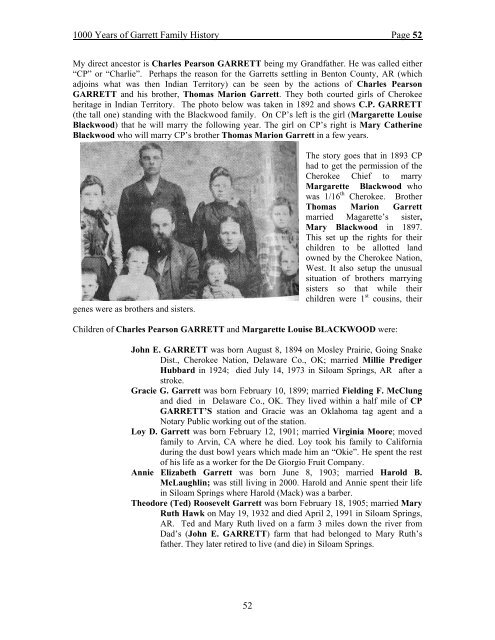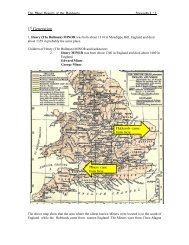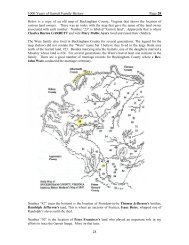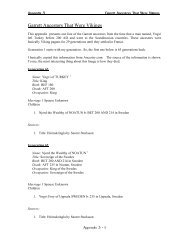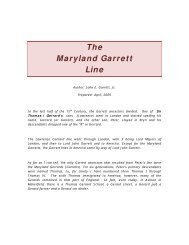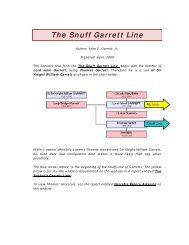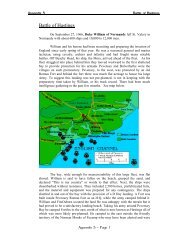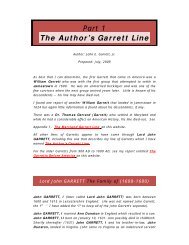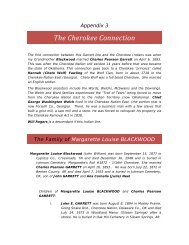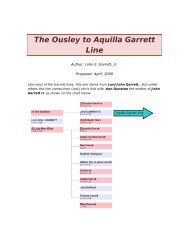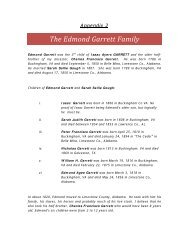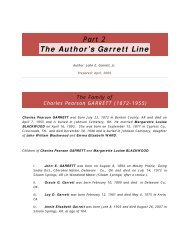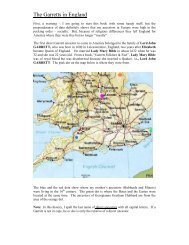1000 Years of Garrett Family History Page 52 52
1000 Years of Garrett Family History Page 52 52
1000 Years of Garrett Family History Page 52 52
Create successful ePaper yourself
Turn your PDF publications into a flip-book with our unique Google optimized e-Paper software.
<strong>1000</strong> <strong>Years</strong> <strong>of</strong> <strong>Garrett</strong> <strong>Family</strong> <strong>History</strong> <strong>Page</strong> <strong>52</strong><br />
My direct ancestor is Charles Pearson GARRETT being my Grandfather. He was called either<br />
“CP” or “Charlie”. Perhaps the reason for the <strong>Garrett</strong>s settling in Benton County, AR (which<br />
adjoins what was then Indian Territory) can be seen by the actions <strong>of</strong> Charles Pearson<br />
GARRETT and his brother, Thomas Marion <strong>Garrett</strong>. They both courted girls <strong>of</strong> Cherokee<br />
heritage in Indian Territory. The photo below was taken in 1892 and shows C.P. GARRETT<br />
(the tall one) standing with the Blackwood family. On CP’s left is the girl (Margarette Louise<br />
Blackwood) that he will marry the following year. The girl on CP’s right is Mary Catherine<br />
Blackwood who will marry CP’s brother Thomas Marion <strong>Garrett</strong> in a few years.<br />
genes were as brothers and sisters.<br />
<strong>52</strong><br />
The story goes that in 1893 CP<br />
had to get the permission <strong>of</strong> the<br />
Cherokee Chief to marry<br />
Margarette Blackwood who<br />
was 1/16 th Cherokee. Brother<br />
Thomas Marion <strong>Garrett</strong><br />
married Magarette’s sister,<br />
Mary Blackwood in 1897.<br />
This set up the rights for their<br />
children to be allotted land<br />
owned by the Cherokee Nation,<br />
West. It also setup the unusual<br />
situation <strong>of</strong> brothers marrying<br />
sisters so that while their<br />
children were 1 st cousins, their<br />
Children <strong>of</strong> Charles Pearson GARRETT and Margarette Louise BLACKWOOD were:<br />
John E. GARRETT was born August 8, 1894 on Mosley Prairie, Going Snake<br />
Dist., Cherokee Nation, Delaware Co., OK; married Millie Prediger<br />
Hubbard in 1924; died July 14, 1973 in Siloam Springs, AR after a<br />
stroke.<br />
Gracie G. <strong>Garrett</strong> was born February 10, 1899; married Fielding F. McClung<br />
and died in Delaware Co., OK. They lived within a half mile <strong>of</strong> CP<br />
GARRETT’S station and Gracie was an Oklahoma tag agent and a<br />
Notary Public working out <strong>of</strong> the station.<br />
Loy D. <strong>Garrett</strong> was born February 12, 1901; married Virginia Moore; moved<br />
family to Arvin, CA where he died. Loy took his family to California<br />
during the dust bowl years which made him an “Okie”. He spent the rest<br />
<strong>of</strong> his life as a worker for the De Giorgio Fruit Company.<br />
Annie Elizabeth <strong>Garrett</strong> was born June 8, 1903; married Harold B.<br />
McLaughlin; was still living in 2000. Harold and Annie spent their life<br />
in Siloam Springs where Harold (Mack) was a barber.<br />
Theodore (Ted) Roosevelt <strong>Garrett</strong> was born February 18, 1905; married Mary<br />
Ruth Hawk on May 19, 1932 and died April 2, 1991 in Siloam Springs,<br />
AR. Ted and Mary Ruth lived on a farm 3 miles down the river from<br />
Dad’s (John E. GARRETT) farm that had belonged to Mary Ruth’s<br />
father. They later retired to live (and die) in Siloam Springs.
<strong>1000</strong> <strong>Years</strong> <strong>of</strong> <strong>Garrett</strong> <strong>Family</strong> <strong>History</strong> <strong>Page</strong> 53<br />
Thomas Henry <strong>Garrett</strong> was born November 18, 1908; married Dolly<br />
Pilkington; died in Siloam Springs, AR. Tom and Dolly were<br />
entrepreneurs owning and operating a various times; a service station; a<br />
café, a hotel; a motel, two auto supply stores; a dress shop and a TV<br />
cable service.<br />
Ruby Irene <strong>Garrett</strong> was born December 19, 1911; married and divorced A. J.<br />
Lacy; married Sam J. Steele; and died about 1998 in Siloam Springs,<br />
AR. Ruby’s first husband was the owner <strong>of</strong> a automobile body shop in<br />
Tulsa, OK and an alcoholic.<br />
Carmen Julius <strong>Garrett</strong> was born May 27, 1918 and died 1919, 18 months old.<br />
Preparatory to Oklahoma statehood that would occur in 1907, those having Cherokee blood were<br />
entered on the “Cherokee Roll”. Margarette’s roll number was 1872. Oldest son John<br />
GARRETT was 1873; Grace <strong>Garrett</strong>’s was 1874; Loy <strong>Garrett</strong>’s was 1875; Anne <strong>Garrett</strong>’s is<br />
probably M something; Ted <strong>Garrett</strong>’s number was M2961. Children with Cherokee blood born<br />
after 1903 were called “too lates” meaning that they were born too late to receive a land allotment<br />
– they did however, receive an allotment <strong>of</strong> cash.<br />
So, CP’s wife and three children received land allotments; two children received cash allotments<br />
and the youngest two received nothing – they were known as “too damned lates”.<br />
Thomas Marion <strong>Garrett</strong>’s wife and two oldest children received land allotments; Millie Ruth<br />
<strong>Garrett</strong> was born soon enough to receive land but Thomas Marion <strong>Garrett</strong> said that all <strong>of</strong> the<br />
good land had been taken so he opted for a $600 cash allotment.<br />
Nora <strong>Garrett</strong>, daughter <strong>of</strong> John GARRETT married Lewis Bradford Allen who was part<br />
Cherokee Indian. Lewis Bradford Allen was born in Indian Territory (near Flint Creek). His<br />
mother was Nancy Mitchell, born February 1, 1839. Nancy was the fifth granddaughter <strong>of</strong> Chief<br />
Moytoy <strong>of</strong> the Cherokee Nation. She was born on the "Trail <strong>of</strong> Tears". Nancy's name sake was<br />
Nancy Ward, Cherokee princess better known as White (or Wild) Rose.<br />
The allotments were from 70 to 90 acres each and the <strong>Garrett</strong>s receiving them took them in one <strong>of</strong><br />
two places. One was in what is now Delaware County, OK and about 3 miles west <strong>of</strong> the state<br />
line in an area called “Moseley Prairie”. The other place <strong>of</strong> favor was 3 or 4 miles south <strong>of</strong><br />
Moseley Prairie on land adjoining the Illinois River in the county that is now Adair County.<br />
After the land allotments, the <strong>Garrett</strong>s owned seven farms all within a few miles <strong>of</strong> each other.<br />
However; the Illinois River turned out to be a divider with those north <strong>of</strong> the river seldom visiting<br />
those south <strong>of</strong> the river. For example, my cousin Glenn Stinchcomb, who was born and raised on<br />
one <strong>of</strong> the land allotments on the Moseley Prairie, and I, who was born in the same year south <strong>of</strong><br />
the Illinois River never knew each other until we were 65 years old.<br />
53
<strong>1000</strong> <strong>Years</strong> <strong>of</strong> <strong>Garrett</strong> <strong>Family</strong> <strong>History</strong> <strong>Page</strong> 54<br />
Below is one <strong>of</strong> the actual land allotments given to John E. GARRETT. There is a second one<br />
that I have. Note that it is from ”The Cherokee Nation” and is dated the 19 th <strong>of</strong> September, 1908.<br />
54
<strong>1000</strong> <strong>Years</strong> <strong>of</strong> <strong>Garrett</strong> <strong>Family</strong> <strong>History</strong> <strong>Page</strong> 55<br />
The above map shows the area including Moseley Prairie; the Illinois River lands; the southern<br />
part <strong>of</strong> Delaware County; the northern part <strong>of</strong> Adair County and Siloam Springs in Benton<br />
County, AR. The red circle is Moseley Prairie; the western red blocks are some <strong>of</strong> the land<br />
allotments; the yellow is for cemeteries where the <strong>Garrett</strong>s are buried; the red square on the state<br />
line is the location <strong>of</strong> CP <strong>Garrett</strong>’s service station and home; the black square is the location <strong>of</strong><br />
John GARRETT’s home; the orange and pink involves ancestors on my mother’s side; and the<br />
heavy green line is the 14+ mile road from my father’s land allotment and home to Siloam<br />
Springs, AR.<br />
Little is known <strong>of</strong> CP GARRETT’s life as a young man; however he must have gone to school<br />
since he could read and write. He loved machinery and owned both a large steam engine and a<br />
threshing machine. My father and CP’s oldest son, John E. <strong>Garrett</strong> had to quit school (5 th<br />
grade) and run CP’s steam engine and threshing machine. Dad would thresh for all <strong>of</strong> the farmers<br />
in a large area going from farm to farm. This would take from one to two months during which<br />
he and his crew would have to eat and sleep with the farmer-customers. He told many stories <strong>of</strong><br />
bad food, bed bugs, hair lice and sleeping in the barns as a part <strong>of</strong> the horrible living conditions.<br />
He attributed that experience to his stunted growth <strong>of</strong> 5’ 4” height and weight <strong>of</strong> less than 140<br />
pounds.<br />
Most <strong>of</strong> Charles Pearson GARRETT’s life was spent operating his business on old Highway 33<br />
at the Arkansas/Oklahoma state line. His place was on the Oklahoma side. His main business<br />
was that <strong>of</strong> a “gas station”. Around 1920 when sons Ted and Tom were still at home, they would<br />
walk westward on the dirt Highway 33 and wait until a car came along, at which time they would<br />
run along beside the car, jump upon the running board and talk the driver into stopping at CP’s<br />
station for gasoline.<br />
On the next page is a photo (looking east) <strong>of</strong> Charles Pearson GARRETT’S service station<br />
taken sometime in the 1930’s. Their living quarters were in the back <strong>of</strong> the station, on the north<br />
side. CP had made his field just north and west <strong>of</strong> the station into an air field and I believe the<br />
55
<strong>1000</strong> <strong>Years</strong> <strong>of</strong> <strong>Garrett</strong> <strong>Family</strong> <strong>History</strong> <strong>Page</strong> 56<br />
people in this photo were attending an air show. The state line is just beyond the building where<br />
the tree line is seen. The car in the lower right foreground is on old Highway 33. CP leased the<br />
air field to John Brown University (located west <strong>of</strong> Siloam Springs and a mile north <strong>of</strong> the<br />
station) but in the 1940’s, CP claimed that John Brown University “cheated” him out <strong>of</strong> it.<br />
The space between the station and the Arkansas line served several functions. At one time it was<br />
a “Port-<strong>of</strong>-Entry” where all trucks entering Oklahoma had to stop. It was a liquor package store<br />
at one time and later a shop from which Grace <strong>Garrett</strong> (oldest daughter <strong>of</strong> CP and Margarette)<br />
sold automobile license plates and notary public services.<br />
To the left and in back <strong>of</strong> the station was CP’s equipment barn where he stored his threshing<br />
machine. At one time, he also had a few tourist cabins built there. Later on, to the left (west <strong>of</strong> the<br />
station was a large windmill that provided water for their home and station. Awfully, a smelly<br />
outdoor toilet was next to the windmill.<br />
During C.P. GARRETT’s lifetime:<br />
The Dr. Pepper s<strong>of</strong>t drink was invented in 1885 by Charles Aderton.<br />
The Coca-Cola s<strong>of</strong>t drink was invented in 1886 by Dr. John Pemberton.<br />
The Pepsi-Cola s<strong>of</strong>t drink was invested in 1898 by Caleb Bradham.<br />
In 1912, Otto Fredrick Rohwedder invented the bread slicer.<br />
The automobile was invented, developed and manufactured by the millions.<br />
The Wrights invent the airplane in 1903.<br />
56
<strong>1000</strong> <strong>Years</strong> <strong>of</strong> <strong>Garrett</strong> <strong>Family</strong> <strong>History</strong> <strong>Page</strong> 57<br />
The Cherokee Connection<br />
The small amount <strong>of</strong> Cherokee blood in the <strong>Garrett</strong>s, all comes from the Blackwoods.<br />
Margarette Blackwood <strong>Garrett</strong> was 1/16 th Cherokee. Her father, John William Blackwood<br />
was a white man from TN. I have a copy <strong>of</strong> a hand written letter to Margarette Blackwood from<br />
John William Blackwood’s brother, James Thomas Blackwood. In his letter, James tells <strong>of</strong><br />
Margarette’s birth as being “on Little Cypress Creek in Wayne County, 4 miles <strong>of</strong> the Ala. Line –<br />
about 20 miles south <strong>of</strong> Waynesboro”. As it turns out, the location is less than 70 miles from<br />
Belle Mina, AL where CP’s ancestors were from. James T. Blackwood had been a minister at<br />
the Cross Roads Church a “short distance away” from where Margarette was born.<br />
Margarette’s mother was Emma Elizabeth Ward, 1/8 th Cherokee from Winston County, AL<br />
which is in northern Alabama (see yellow dot) and on the edge <strong>of</strong> the original Cherokee Nation,<br />
East.<br />
Margarette’s grandmother was Margaret Ann WELCH who was 1/4 th Cherokee. Margaret<br />
Ann Welch’s father was George<br />
Washington Welch who along with his<br />
wife, Margaret Jones were both 1/4 th<br />
Cherokee. Minor (not principle) Chief<br />
George Washington Welch lived in<br />
Cherokee County, GA and owned a mill that<br />
he built with slave labor in 1820 and a store<br />
built in 1830. The location <strong>of</strong> the mill and<br />
store is represented by the black dot on the<br />
map on the left and was only a few miles<br />
from where Frances Bates <strong>Garrett</strong>’s<br />
grandfather (William Erwin Bates) was<br />
born. When George Washington Welch<br />
was dispossessed, the government appraised<br />
his property at $12,500. According to the<br />
1835 Cherokee Census, in George Washington Welch’s household were “6 quarter bloods, one<br />
slave, one marriage with white race, one farmer, two readers <strong>of</strong> English, one weaver and two<br />
spinners’.<br />
George Washington Welch’s mother, Elizabeth McSwain and her father, David Welch were<br />
both 1/4 th Cherokee.<br />
Elizabeth McSwain’s mother, Nannie Downing was ½ Cherokee. Her father was Alexander<br />
“Trader” McSwain who, as the name implies, was a trader. Nannie Downing was born where the<br />
yellow dot is on the above map. Nannie Downing’s mother was a full blood Cherokee <strong>of</strong> the<br />
Wolf Clan whose Indian name was Cheto Wolf and whose English name was Hannah Fawling.<br />
Hannah Fawling had married an English soldier, named Major John Downing around 1735.<br />
Some accounts say that Major Downing was captured by the Indians, tortured, mutilated, and<br />
burned at the stake at Fort 96, South Carolina. The red dot on the above map is the area <strong>of</strong> where<br />
Major John Downing may have been killed. Other accounts report that he died a natural death<br />
in 1793 in Northumberland Co., VA.<br />
57


